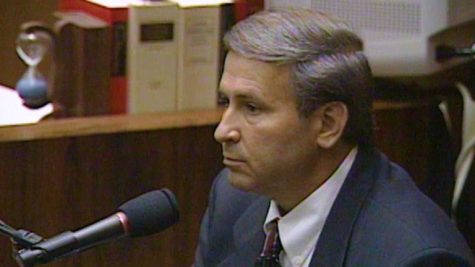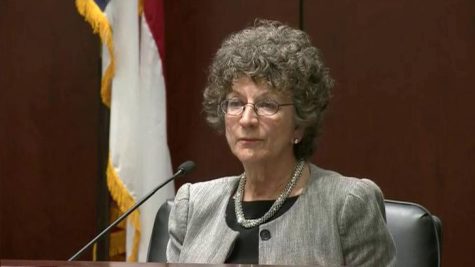The First Few Days
April 21, 2022
Over the course of the first two days, the defense called three witnesses to the stand. Only two of the three were able to be cross-examined by the state before 5 p.m. on Tuesday.
Julie Bridenstine, staff attorney for the N.C. Innocence Inquiry Commission and the lead investigator on Bryant’s claim-of-innocence case, was the first to be called to the stand. Bridenstine would remain under oath for nearly five hours, both Monday afternoon and Tuesday morning.
The defense’s questioning of Bridenstine provided a preliminary understanding of the original investigation in terms of suspects, evidence, eyewitness interviews and leads from Nov. 15-19, 2002 — the day of Jones’ murder to the day of the five arrests. The defense also inquired about what investigating Bridenstine and the Inquiry Commission completed from Feb. 2016 to March 2020.
When asked about Jones’ Lincoln Town Car, Bridenstine said that before Jones was discovered to be dead, a friend had driven by the house and noticed Jones’ Lincoln parked in the carport with the brake lights on and a man in the driver’s seat. Because of the sunset, the eyewitness could not make out any details but could determine it was not Jones, as the man’s figure was too small. They had presumed it was one of Jones’ grandsons and drove away. Bridenstine testified that the police report stated the interior of the Lincoln was forensically processed, but testimony from the trial said otherwise.
Bridenstine also focused on forensic evidence, noting that partial DNA profiles were created based on DNA found on a piece of black tape. The DNA could not be identified, but it did not correlate with any of the five teenagers. When tested again in 2020, the defendants were still excluded from the DNA.
Black’s car, which was allegedly used as the getaway car, was tested for blood and no traces could be found.
Bridenstine also said that there were a few suspects that the WSPD had been notified of either through interviews or Crime Stoppers tips, but once the teenagers were arrested on Nov. 19, all other investigations ceased. Bridenstine attempted to contact at least three of the alternate suspects when she was doing her investigation but did not receive any new information.
The defense also asked about an eyewitness report from 10-year-old BJ Lowery, who claimed to have seen a Hispanic male dressed in black, wearing a tobaggan hat and gloves, jump over Jones’ fence. The first report notes that the child said it was 5:59 p.m., whereas during trial, Lowery is on record as saying it was closer to 7:50 p.m. — a substantial time difference.
Bridenstine testified that Lori Douglas, Lowery’s mother, was hosting a birthday party at the time when her son came into the house saying he had seen something. Douglas said Lowery had notified her between 6:30-6:40 p.m. — the same time frame as Jones’ death. The defense said that this suspect description was eliminated for unexplained reasons.
When the state had the opportunity to cross-examine, they asked if Douglas was under oath when she clarified the time. She was not. The prosecution repeatedly asked Bridenstine if she had thoroughly explored all the possible avenues of the investigation. She maintained she had.
Three exchanges between the defendants, relatives of the defendants and counsel were introduced as evidence by the prosecution. One of those was a memo written by N.C. Center on Actual Innocence attorney Cheryl Sullivan summarizing a phone call between her and Nils Gerber, who represented Bryant in the original trial. The memo said that Gerber believed all five of the teenagers were guilty of murdering Jones, saying that while the confessions may have been coerced by WSPD officers, they were “still truthful”.
The defense added that Gerber would later dispute telling Sullivan about any opinions of guilt.
Around 11:45 Tuesday morning, William Bodziak was called to the stand as an expert in footwear impressions. Bodziak worked in forensics for the FBI for nearly 25 years before starting a forensic consulting business in Jacksonville, FL. He also testified in the famous trial of O.J. Simpson. He estimated that he had testified more than 500 times and that three-quarters of those testimonies pertained to footwear impressions.

Two partial shoe prints were found on the hood of Jones’ Lincoln Town Car and were identified to be the soles of a size-nine Air Force 1 shoe.
Investigators had seized a pair of size-nine Air Force 1s from the home of Cauthen and Banner, claiming that these were the shoes that left a print on the hood of Jones’ car. But Bodziak would later testify that it was erroneous for the police to use partial impressions of one of the most common shoes in the U.S. as the sole piece of forensic evidence linking the teenagers to the murder.
“There is nothing special about the wear,” Bodziak said, referring to scuffs and tread on the bottom and sides of the shoe. “To use these features and infer a connection is misleading.”
Bodziak was also reluctant for both sides to use the word “match” in reference to any connection.
“Once the word ‘match’ is used in a courtroom, you don’t know what that means to people,” Bodziak said.
“Corresponds” is the preferred terminology — but with partial impressions showing general wear, Bodziak said a correspondence would be far from absolute.
The final witness of the day was Dr. Ginger Calloway, a forensic psychologist with more than 30 years of experience in the field of developmental psychology. When questioned by the defense, she defined what intellectual disabilities (IDs) are and outlined the three-pronged test used to determine them. Calloway emphasized that the test data was conclusive, using multiple sources from multiple examiners.

“You wouldn’t rule out or rule in ID based on one piece of data,” Calloway said.
The psychological assessments she discussed included — but were not limited to — standardized tests such as IQ tests, the Woodcock-Johnson test, the CAT and WRAT tests.
When asked for her opinion, Calloway affirmed that, based on case records — including her own psychological assessments — each of the five teenagers was cognitively impaired at the time of interrogations in 2002. Her findings supported the defense’s claim that the boys were more likely to make false confessions based on their age and mental impairment.
The prosecution, as of 11:00 a.m. Wednesday morning, cross-examined Calloway regarding the thoroughness of her investigation and the impact the defendant’s many absences from school may have had on their capabilities. The hearings will last the remainder of this week and are likely to continue into the next.